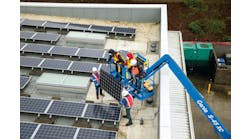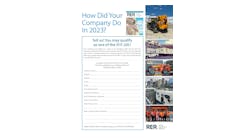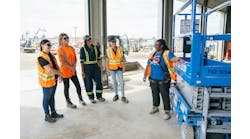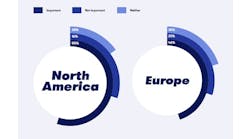The Associated Equipment Distributors 2006 rental study illustrates the dramatic shift that has occurred among distributors towards rentals. AED’s study indicates that by 2005, 99 percent of equipment dealers were in the rental business, and 92 percent of those offer both rent-to-rent and rent-to-own equipment. Only 5 percent of dealers said they only allow customers to rent-to-own, and 30 percent make their rental fleets available for daily rentals 100 percent of the time. In 1980, only 57 percent of dealers were renting; by 1985 the number had gone up to 69 percent; in 1990, 77 percent; 83 percent by 1995; and by 2000, 89 percent had rental fleets.
One surprising trend the study showed was that only 6 percent have rental and sales operations at different locations, down from 20 percent in 2001. Only 17 percent have different names for their rental operations, although 55 percent maintain separate profit-and-loss statements for rental and sales operations. More than half of the dealers manage rental fleets using a combination of time and dollar utilization, while 24 percent use dollar utilization only and 11 percent time utilization only.
Most dealers use dealership technicians to perform routine maintenance and major repairs on rental fleet; less than 20 percent use dedicated rental fleet technicians to handle routine maintenance on the rental fleet.
Dealers are continually changing and diversifying their rental fleets. In 2005, about 60 percent of heavy and medium equipment dealers diversified their fleets with new sizes of equipment; more than 50 percent added new equipment types and nearly 40 percent added new brands.
Many practices common to dedicated rental companies are becoming standard among dealerships. For example, nearly three-fourths of survey dealers said they rent equipment to rental companies and other dealerships that then rent the machines to their customers. Seventy-five percent of survey dealers move equipment between locations to meet customer demand. When it comes to delivering rental equipment, 84 percent of surveyed dealers delivery and pick up rental equipment, 72 percent of which use their own trucks. An overwhelming 97 percent charge for delivery and pickup of equipment.
AED also surveyed rental companies and found 66 percent of companies added new brands to their fleets in 2005, 74 percent added new sizes and 79 percent added new equipment types. Eighty-five percent of respondents said they are growing the size of their fleets in 2006.
Sixty percent of rental companies said they sell equipment to their customers using rent-to-own transactions, and 98 percent pick up and deliver equipment. Seventy-one percent re-rent equipment to other rental companies and dealerships. Sixty-five percent of rental companies use software specifically designed for rental operations, while only 29 percent of dealers use rental-specific programs.
Most rental companies use dedicated rental fleet technicians to perform both routine maintenance (68 percent) and major repairs (65 percent), the study said.
In 2006, 69 percent of manufacturers are selling direct to national and regional rental companies, rather than through dealers, a number that has decreased from 71 percent in 2001. Only 36 percent of the manufacturers that sell direct to rental companies compensate their dealers for those sales. More than 80 percent of the manufacturers that sell direct to rental companies expect the rental companies to perform routine maintenance on those items, a percentage that has increased from 68 percent in 2001. Sixty percent also expect the rental companies to perform major repairs, up from 34 percent in 2001. Although 47 percent of surveyed manufacturers said they sell direct to rental companies with fewer than three locations, the number is down from 53 percent in 2001. Manufacturers said that 75 percent of their dealer networks are in the rental business, but 100 percent of the top 20 percent of their dealers have rental fleets.
The median manufacturer sells 75 percent of production to its dealer network, 15 percent to rental companies and 10 percent direct to the end user.
An increasing quantity of manufacturers are selling more to national and regional rental companies, with 45 percent saying they sold more in 2005 than in 2004, and none saying they sold less to large rental companies in 2005. The median increase among those who increased sales to rental companies in 2005 was 15 percent, with responses ranging from 5 to 70 percent.
Twenty-six percent of manufacturers say they have become integrated into the rental company’s business, while the same number expect rental to be the leading acquisition method for light equipment. Eighteen percent said they provide electronic invoicing, customized training and factory-direct service to rental companies. A small number — 6 percent — said they provide products to rental companies that they do not offer their dealer networks.
As for pricing to rental companies, 49 percent of surveyed dealers say discounts to rental companies depend on volume, while 42 percent said none pay less than authorized dealers. Thirty-one percent say they may sell to rental companies at dealer net if there is no dealer in the area. Twenty-eight percent say if a dealer can do the same volume as a rental company, it can get the same discount, while 26 percent said dealers get same discount as rental companies.
Most manufacturers said their relationships with their dealer networks have not been impacted by the company’s rental strategy, and 25 percent think it’s better.
The complete AED Rental 2006 study is available from the Associated Equipment Distributors. For more information, check out www.aednet.org.





